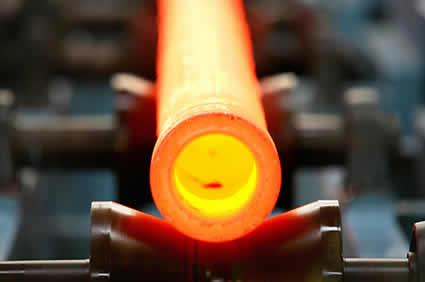Extrusion is the process by which long straight metal parts can be produced. The cross-sections that can be produced vary from solid round, rectangular, to L shapes, T shapes. Tubes and many other different types. Extrusion is done by squeezing metal in a closed cavity through a tool, known as a die using either a mechanical or hydraulic press.

Extrusion produces compressive and shear forces in the stock. No tensile is produced, which makes high deformation possible without tearing the metal. The cavity in which the raw material is contained is lined with a wear resistant material. This can withstand the high radial loads that are created when the material is pushed the die.
Extrusions, often minimize the need for secondary machining, but are not of the same dimensional accuracy or surface finish as machined parts. Surface finish for steel is 3um; (125 uin), and Aluminum and Magnesium is 0.8 um (30 uin). However, this process can produce a wide variety of cross-sections that are hard to produce cost-effectively using other methods. Minimum thickness of steel is about 3 mm (0.120 in), whereas Aluminum and Magnesium is about 1mm (0.040 in). Minimum cross sections are 250 mm2 (0.4 in2) for steel and less than that for Aluminum and Magnesium. Minimum corner and fillet radii are 0.4 mm (0.015 in) for Aluminum and Magnesium, and for steel, the minimum corner radius is 0.8mm(0.030 in) and 4 mm (0.120 in) fillet radius.
Cold Extrusion: Cold extrusion is the process done at room temperature or slightly elevated temperatures. This process can be used for most materials-subject to designing robust enough tooling that can withstand the stresses created by extrusion. Examples of the metals that can be extruded are lead, tin, aluminum alloys, copper, titanium, molybdenum, vanadium, steel. Examples of parts that are cold extruded are collapsible tubes, aluminum cans, cylinders, gear blanks. The advantages of cold extrusion are:
- * No oxidation takes place
- * Good mechanical properties due to severe cold working as long as the temperatures created are below the re-crystallization temperature
- * Good surface finish with the use of proper lubricants
Hot Extrusion: Hot extrusion is done at fairly high temperatures, approximately 50 to 75 % of the melting point of the metal. The pressures can range from 35-700 MPa (5076 – 101,525 psi). Due to the high temperatures and pressures and its detrimental effect on the die life as well as other components, good lubrication is necessary. Oil and graphite work at lower temperatures, whereas at higher temperatures glass powder is used.
Typical parts produced by extrusions are trim parts used in automotive and construction applications, window frame members, railings, aircraft structural parts.
Post time: May-24-2016

